Cross country is an active team sport commonly raced in high schools, middle schools, and colleges across the country. As jogging has gained popularity in the last 20 years, running as a school sport has grown as well.
As a cardiovascular sport where you race at your own pace, it’s a sport that allows all ability levels to participate at the same time, on the same course, on the same day. Accessibility, health, and fun are all reasons that the discipline has taken off. Another reason for its popularity? The low need for equipment: all you need to participate is a uniform (often provided by the school or organizer) and a pair of running shoes.
Contents
- Features to Consider in a Cross Country Shoe
- The 10 Best Cross Country Shoes in 2024
- 1. Best Overall Cross Country Shoes: Saucony Men’s Kinvara 11 Running Shoe
- 2. Best Premium Cross County Shoes: Brooks Ghost 12
- 3. Best Budget Cross Country Shoes: Adidas Men’s Energyfalcon Adiwear Running Shoes
- 4. Asics Men’s Gel-Venture 7 Trail Running Shoes
- 5. Best Cross Country Spikes: Asics Men’s Hyper XC
- 6. Best Women’s Cross Country Shoe: Nike Women’s Competition Running Shoe
- 7. Best Hot Weather Training Shoe: Mizuno Men’s Wave Inspire 16 Road Running Shoe
- 8. Best Cross Country Spike for Women: Saucony Women’s Kilkenny XC5 Spike
- 9. Best Women’s Shoe for Wide Feet: Asics Women’s Gel-Venture 7 Running Shoes
- 10. Under Armour Men’s Charged Assert 8 Running Shoe
- Guide to Buying the Best Cross Country Shoes for 2024
- Wrapping Up
Features to Consider in a Cross Country Shoe
Running shoes are actually surprisingly diverse. From ultra-lightweight spikes to super-supportive running trainers, cross country sneakers have huge variations. For this reason, it requires a bit of know-how to pick the right shoe. When shopping for a pair of runners for cross country, consider the following factors.
If you’re a seasoned runner and know what you’re looking for already, then you can jump ahead and go straight to our choices and find your next pair of shoes.
Spikes, Flats, or Runners?
Principally, there are three main types of shoes used in cross country. Each of them has their own unique purpose in the sport, and the most serious runners might have a pair of each. Runners are the most important to have, followed by spikes and flats.
Runners
When just starting out in the sport, the most important shoe you can purchase is a training running shoe. These shoes offer a high degree of durability and support while also being relatively lightweight and quick. Although we’d recommend spikes for racing, it is very common for beginners to use standard running shoes for competitions.
Spikes
Spikes are ultra-lightweight shoes that are meant for the off-road racecourses of cross country competitions. They utilize screw-in metal studs that help improve the grip of the shoe on less-than-ideal conditions. They’re typically only used for races or race simulations.
Flats
Flats are the least common type of shoes for cross country running, with a similar lightweight form factor to spikes. Unlike spikes, though, they don’t use screw-in metal studs, so they’re more commonly used for workouts on the track or on the road.
Upper Material
The material of the shoe is important and affects weight, comfort, and durability. While many shoes use composite and synthetic materials, here are a few of the most common materials you will find.
Polyester
A cheap and versatile synthetic, polyester is frequently used for its low price and wide variety of applications. Polyester comes in various forms, from plush interior fabrics to outer mesh ones and everything in between. Polyester fabrics can be made cheaply and expensively, so make sure that your running shoe manufacturer isn’t just trying to cut costs by incorporating polyester.
Nylon
Nylon is typically used as a waterproof but relatively breathable shoe layer. With high tech breathable waterproof membranes becoming more popular, it’s seen less often, but it is still common in mid-range to budget-range shoes.
Mesh
To create comfortable, well-aerated shoes, manufacturers use mesh materials to improve airflow and minimize weight. Meshes, since they’re not as durable as traditional fabrics, are not great for trail running and might wear out a bit quicker, but come with performance advantages.
Proprietary Fabrics
In an effort to differentiate from competitors, running shoe manufacturers frequently invent unique materials that have special properties specific to their shoes. These should be evaluated independently and may contain various common or exotic materials. Some examples of these fabrics are Nike Flyknit and Ortholite sockliners.
Sole Construction
Soles are arguably the most important part of running shoe construction as they affect the athlete’s stride, helping to preventing injury and creating a more efficient gait. Manufacturers use a huge range of materials to get their ideal combination of support, durability, and comfort, but the most common material is Carbon Rubber, a synthetic rubber that’s combined with carbon for durability. Manufacturers often add EVA foam, plastic, or even gel liquid pockets to modify the level of support.
Level of Support
While there are whole articles dedicated to how running shoe construction and support affect running stride asymmetries like pronation, overpronation, and supination, the concepts can be roughly simplified to:
High Support
For overpronators, whose feet push outwards while running, a high level of support is required to correct the running stride, reducing the possibility of injury and improving running efficiency.
Mid-Level Support
Most runners will require a middle-ground level of support that holds up the foot, allowing the runner’s gait to be comfortable and quick.
Neutral Support
Those with a natural stride will look for a shoe with neutral support that won’t affect their running gait. Minimal shoes, zero-drop shoes, and barefoot-style shoes all fall in this category.
Supination Support
Those whose feet bend inwards while running are classified as ‘supinators’ and are particularly at risk for repetitive-use injury. These runners should look for a specifically-designated supination shoe to minimize the risk of discomfort and injury while running.
What Kind of Runner Are You?
All the support in the world can’t do you much good if you don’t know where you need it: for this reason, before you buy a shoe, you should learn what type of stride you have. For a cross country runner, a valuable asset could be a coach, experienced teammate, or a physical therapist that can help you what kind of stride you have. If you don’t have one of those available, you can perform a gait test to understand your stride inconsistencies.
The simplest one of these tests is to take a peek at the bottom of your shoes. Your most recent pair of running shoes is ideal, but even a shoe you wear in the day-to-day will give you some powerful clues to identify your stride type.
Now that we’re on course, it’s time to break away from the pack with one of our favorite running shoes.
The 10 Best Cross Country Shoes in 2024
1. Best Overall Cross Country Shoes: Saucony Men’s Kinvara 11 Running Shoe
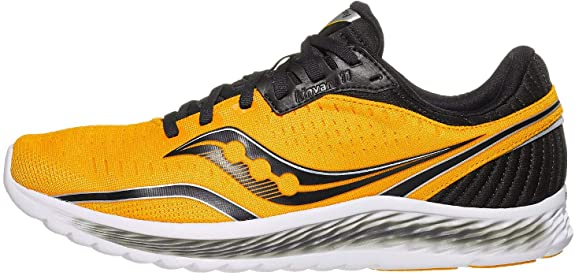
Editor’s Rating:
At a Glance:
- Shoe Type: Runners / Flats
- Size Availability: 3.5 to 15 in half-sizes
- Upper Material: Synthetic / Mesh
- Sole Material: Foam
Saucony has long produced workhorse running shoes and has created another fantastic option for cross country runners with this shoe. It’s meant primarily for competitive runners, and targeted at those with a neutral-stride putting in long training miles. These fantastic-looking training shoes aren’t only good for grinding through big training miles, though: we like the way they look and their comfortable design as well.
The true innovation in this shoe comes in the form of a parabolic sole, helping transfer the energy from the fall of the foot into the push-off, simultaneously increasing efficiency and cushioning.
Unfortunately, for this tech to function properly, a neutral stride is needed. The design of the sole can exacerbate stride imperfections, so if you overpronate, we’d recommend a shoe like the Brooks Ghost 12.
While these shoes are manufactured in a broad range of sizes, from the kid-sized 3.5 to the standard top-end of 15, wide sizes are only available in some colors, making them tricky to find, although it’s better than not having a wide option available at all. On the other hand, thanks to these 13 color options, there’s a style available for everyone, although our favorite is the ultra-clean pure white design.
Support
While a neutral shoe support design means that overpronators and supinators are better off looking elsewhere, this isn’t a zero-drop or barefoot-style running shoe by any means. Footfalls are well cushioned by a relatively thick footbed, largely eliminating shin splints and heel pain. The one thing to note is the effect of wear-and-tear on the parabolic sole. If it begins to wear out unevenly, it could end up exacerbating repetitive-use injuries.
- Workhorse shoes meant for grinding through big training miles
- Parabolic sole saves energy and cushions the foot
- Attractive design with 13 color options
- Thick sole prevents heel and shin pain
- Not meant for those who overpronate or supinate
- Wide sizes not available in all color options
2. Best Premium Cross County Shoes: Brooks Ghost 12

Editor’s Rating:
At a Glance:
- Shoe Type: Runners
- Size Availability: 6.5 to 15 in half-sizes (Narrow, Wide, X-Wide)
- Upper Material: 3D Mesh Upper
- Sole Material: Custom Synthetic
While sporting apparel behemoths like Nike and Adidas spread their research and development budget across a range of sports, Brooks exists for one reason: helping runners. And it’s probably for this reason that the Brooks Ghost 12 is such an outstanding shoe: the designers, fabricators, and exercise physiologists behind this shoe are all runners, and they have catered this shoe to runners.
A custom insole and a 3D mesh upper complement the main construction of the shoe to yield a premium-priced sneaker that feels like it isn’t even there. But while this airy comfort is outstanding, a running shoe still has to fit right, and a full range of sizes plus versions in of the model available in Narrow, Wide, and X-Wide formats means that even those with less-common sized feet can find something that will work perfectly.
Another (admittedly small) gripe we have with these shoes is their looks. Brooks has never made the best looking sneakers. Frankly, they don’t do any better than normal with this shoe. Both Nike and Adidas make better-looking shoes, but the performance-oriented cross country runners will understand that looks aren’t everything.
Support
A neutral footbed is supportive enough for most runners but still manages to keep things simultaneously lightweight and well-cushioned. The heel of the shoe is made of a technology called ‘crash pad,’ which is a matrix-like structure meant to disperse energy from heel strikes across the foot. This heel pad is proven to reduce the likelihood of heel pain and shin splints. These shoes are relatively supportive for overpronators, but don’t do a fantastic job for those who have severe stride imbalances, supinators included.
- Lightweight yet well-cushioned trainers
- Custom insole and 3D mesh upper yield a barefoot-feeling shoe
- Crash pad technology reduces likelihood of heel pain and shin splints
- Narrow, Wide, and X-Wide versions
- Not the best looking shoes
- Relatively pricey
3. Best Budget Cross Country Shoes: Adidas Men’s Energyfalcon Adiwear Running Shoes
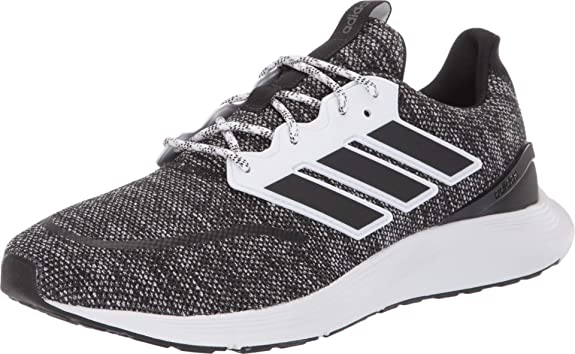
Editor’s Rating:
At a Glance:
- Shoe Type: Runners
- Size Availability: 6.5 to 15 in half-sizes
- Upper Material: Elastic Upper
- Sole Material: Synthetic Rubber
Serious Adidas training shoes have been on the market since before the running boom of the 1970s, and although Adidas hasn’t become as large or technologically advanced as other players like Nike, Asics, or Brooks, the company is still dedicated to making high-quality running-specific products.
This shoe is designed with a universal fit in mind, with its stretchy upper material working with runners who have both narrower and wider feet. The insole has a midfoot support panel and a foam cushion to help absorb some of the discomfort caused by hard-surface running (often on the tracks and endurance days of cross country practices).
The Adiwear outsole combines comfort and practicality on the outer sole of the shoe as well, with a proprietary cushioned Cloudfoam midsole combining with an Adiwear outsole that brings exceptional durability to this product: expect to get well over 500 miles with these shoes.
An Ortholite sockliner not only improves comfortability and breathability overall, but also makes it possible to use these shoes without wearing socks, although a switch to Chinese manufacturing means that the bottom of the shoe occasionally has uncomfortable seams that can chafe and rub against the foot.
Support
Basing the design of the shoe on the more minimalist, barefoot-style designs that have become popular in the last ten years, these trainers have neutral support that might not work particularly well with overpronators and underpronators (supinators), although the minimal support is still comfortable and lightweight for other runners. Although it’s a minimal shoe, it is still not quite a barefoot running shoe, and thus offers a molded heel and a slightly elevated arch-supporting insole.
- Minimal shoe is lightweight yet still contains some cushioning
- Ortholite sockliner improves comfortable and breathability
- Long-lasting design can squeeze out over 500 miles of use
- Includes an arch-supporting insole
- Neutral design not for those with pronation issues
- Uncomfortable seams that chafe and rub against the foot
4. Asics Men’s Gel-Venture 7 Trail Running Shoes
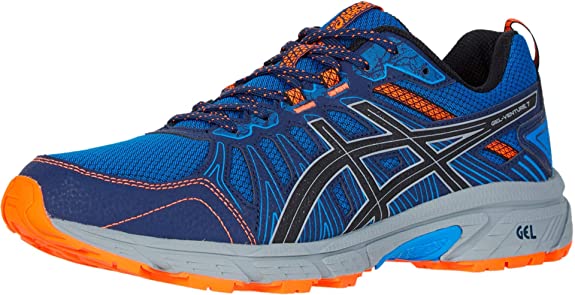
Editor’s Rating:
At a Glance:
- Shoe Type: Runners
- Size Availability: 7 to 15 in half-sizes, Wide version available
- Upper Material: Synthetic Leather and Mesh
- Sole Material: Rubber
Cross Country is a discipline of running that requires a versatile shoe due to varied terrain, and the Asics Gel-Venture 7 is one of the most versatile running shoes out there. While a durable construction, a breathable Ortholite X-40 Sockliner, and a grippy sole make things great for rougher terrain and more technical cross country courses, a lightweight construction means this shoe is plenty quick for the on-road and track workouts.
The upper is rigid and supportive at the price of sacrificing the mesh-equipped breathability we see on shoes like the Saucony Men’s Kinvara 11 Running Shoe, although it’s by no means a poorly-ventilating shoe. Under the foot, Asics provides a comfortable contoured footbed with a built-in heel cup that is designed to help a runner’s stride become more efficient.
All these features come at the cost of bulkiness, though, and this footwear is not sleek, minimal, or even particularly stylish, although it does come in fourteen different color options. Even with the bulky format, the fact that Asics included additional ‘X-Wide’ sizes available for wide-footed runners proves that perennial running shoe favorite Asics hasn’t missed a thing.
Support
This shoe has a medium amount of support for both supination and overpronation prone runners. Runners who overpronate will hit the ground with the outer edge of the foot, leading to strong impacts against bones and tendons. Asics corrects for that with a slight lean through the sole of the shoe, helping the foot come down evenly.
- Lightweight shoe great for variable terrain
- Works for technical cross country courses and on-road running
- X-Wide sizes available for wide-footed runners
- Medium amount of support for overpronators
- Fourteen different color options
- Synthetic leather upper isn’t particularly breathable
- Not very stylish
5. Best Cross Country Spikes: Asics Men’s Hyper XC
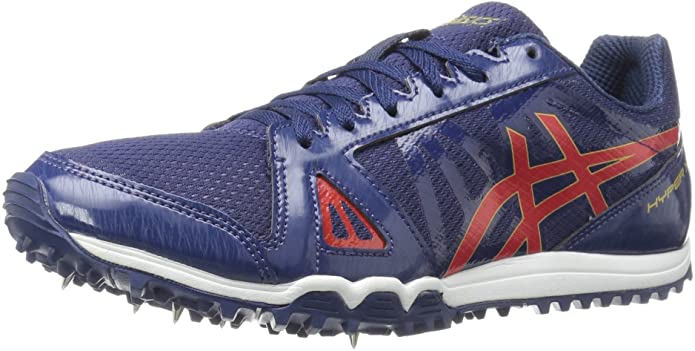
Editor’s Rating:
At a Glance:
- Shoe Type: Spikes
- Size Availability: 4.5 to 15 in half-sizes
- Upper Material: 50% synthetic / 50% Mesh
- Sole Material: Lugged Rubber with Spikes
Once a cross-country runner gets into racing and begins to have something to show for it in the way of results, it’s a good time to consider purchasing a first pair of spikes. These ultra-lightweight shoes can weigh as little as six ounces a pair. On this model, each shoe has five holes which accept stainless steel ¾ inch spikes to help the runner maintain sturdy traction against the ground when racing.
It’s important to note that cross country spikes are only for use on off-road grass and dirt cross country courses. Spikes don’t work at all on asphalt or cement and don’t offer support or additional grip. If you’re doing any on-road racing, use a pair of standard running shoes like the Saucony Men’s Kinvara 11 Running Shoe or a pair of lightweight running flats like the Brooks Ghost 12.
These Asics Men’s Havoc spikes are a great option for an inexpensive first pair of spikes. While the minimalist design keeps them light, Asics still fits a technology called ‘Trussic System’ into the shoe, improving structural integrity as well as helping to retain it. One note—the narrow design of these shoes makes them best for cross country runners who have average or narrow feet. Runners with wide feet should look elsewhere, especially considering these aren’t available in wide sizes.
Support
Since racing spikes are meant to be lightweight and as minimal as possible, they offer very little in the way of support. An ultra-thin sock-like upper wraps around the top of the foot, while a zero-drop sole doesn’t cushion the arch or the heel. Since runners typically only race once every couple of weeks during the season, the lack of support really isn’t an issue.
- Lightweight racing spikes perfect for off-road cross country courses
- Breathable, minimal mesh upper helps keep the foot cool
- Spikes create incredible grip
- Asics’ proprietary ‘Trussic System’ improves structural integrity
- Not meant for runners with wide feet
- Lack of support
6. Best Women’s Cross Country Shoe: Nike Women’s Competition Running Shoe
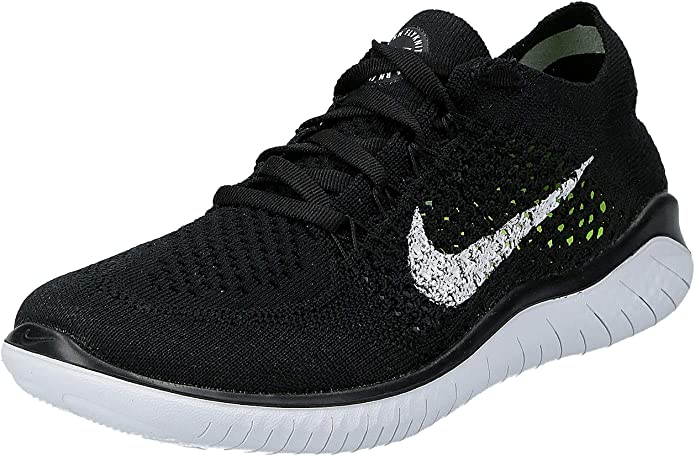
Editor’s Rating:
At a Glance:
- Shoe Type: Runners
- Size Availability: 5 to 14.5 in half-sizes
- Upper Material: Nike Flyknit
- Sole Material: EVA Foam
While Nike might be better known now for their basketball shoes and apparel, the brand has always maintained close ties with the running world—and it is their decades of research, development, and collaboration with elite runners that allows the company to consistently release excellent products like the Women’s Competition Running shoe.
A classic running style trainer with support for those who have a more neutral stride, this women’s specific shoe is lightweight, minimal, and comfortable, perfect for cross country training. Nike’s Flyknit upper material is a revelation, hugging to the top of the foot like a sock, both ventilating well and eliminating hot spots and chafing—although be aware it might wear through a bit faster than normal.
The EVA foam soal contributes to the general look and construction shoe. As far as aesthetics go, the Flyknit material, futuristic shape, and attractive colorways make this one of the best-looking shoes in today’s running shoe lineup – without any sacrifices in performance.
Support
Nike doesn’t usually make ultra-supportive shoes, and these are no exception. While an EVA foam sole does a good job of cushioning against hard surfaces, there’s no real support in these shoes for either overpronators or supinators.
Those looking for support should check out the Asics Women’s Gel-Venture 7 Running Shoes for a classic style runner or the Women’s Kilkenny XC5 for a race-ready shoe.
- Neutrally supportive, lightweight shoe is great for cross country running
- Attractive shape and futuristic colorways
- Flyknit material is ventilative and comfortable
- EVA foam sole helps cushion
- Doesn’t have much support
- Flyknit material wears out more quickly than normal
7. Best Hot Weather Training Shoe: Mizuno Men’s Wave Inspire 16 Road Running Shoe
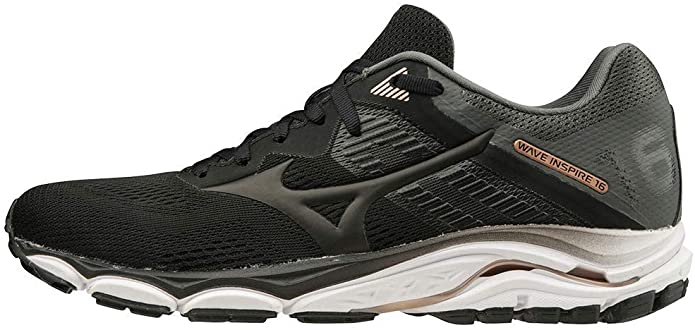
Editor’s Rating:
At a Glance:
- Shoe Type: Running Shoe
- Size Availability: 7 to 16 (half-sizes 7.5 to 12.5, wide sizes available)
- Upper Material: Mesh Sockliner
- Sole Material: EVA / Rubber
Mizuno is a relatively niche manufacturer. It’s a Japanese company that has grown drastically over the last 10 years into a well-known, runner-oriented shoe brand. Most of its popularity has come in the form of technological innovation, with the company able to provide lightweight shoes with fantastic levels of support.
This shoe is no different, and a plastic plate molded into its EVA/rubber sole provides support and additional springiness and leads to a quick-feeling shoe. Slightly less supportive is the upper, with an ultra-breathable synthetic mesh ‘sockliner’ that’s meant to keep the foot cool.
While the sockliner is lightweight enough to be cool even in hot temperatures, it still provides some support where it matters: around the ankle and the midfoot. This stability mixed with a lightweight format means it’s one of the best shoes for long, hot summer runs.
Mizuno also incorporates a specially-engineered outer sole that maximizes durability and shock reduction. While most EVA-sole shoes last closer to 300 miles, it’s reasonable to get around 500 miles out of this pair of sneakers. An updated heel collar adds to the appeal, although the springy sole is best for middle distances: think 10k summer training runs and 800m repeats more than half marathons, which is fine for cross country running and training purposes.
Support
There are both pros and cons for the support level of this shoe, with Mizuno making some unique design choices that more or less balance each other out.
A plastic sole plate adds spring and corrects gait, but can overcorrect some milder stride imbalances. The lightweight mesh upper keeps feet cool but doesn’t quite support the ankle as well as more supportive shoes like the Brooks Ghost 12.
Our final verdict? It helps with minor gait imperfections for both underpronators and overpronators, although it’s probably insufficient for those who need a higher level of support.
- Lightweight and springy shoe feels quick
- Updated heel collar
- Supportive yet cool sockliner-style upper
- Lasts longer than a typical EVA shoe
- Insufficient for those who need a high level of support
- Not great for longer distance racing
8. Best Cross Country Spike for Women: Saucony Women’s Kilkenny XC5 Spike
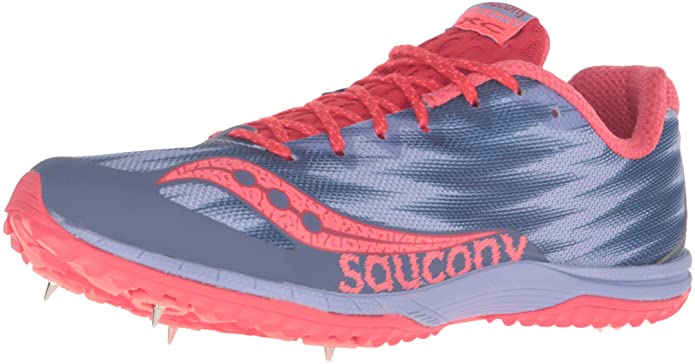
Editor’s Rating:
At a Glance:
- Shoe Type: Spikes
- Size Availability: 6 to 11
- Upper Material: Synthetic Mesh
- Sole Material: EVA Foam / Carbon Fiber
When cross country athletes begin to take the sport a bit more seriously, it’s time to start considering a pair of grippy and lightweight spikes to take performance to new heights. While the market is full of spikes targeted at male athletes, it’s sometimes tricky for women to find a solid pair of spikes. But with the always-solid shoe manufacturer Saucony taking a crack at producing a high-quality cross country women’s spike, there’s at least one good option out there for female racers.
While women’s and men’s spikes are typically nearly identical in engineering, just getting a new paint job for women’s versions. these Saucony Kilkenny XC5s actually use a construction which is specific for women’s feet.
While this adds a couple ounces in weight, it improves the feel, especially for the mid-distance to longer-distance races common in collegiate categories. These shoes thrive in races 8 kilometers and up.
With a carbon fiber outsole keeping the sole of the shoe rigid and therefore efficient, the bottom of the shoe incorporates four spikes, a little lower than the industry norm of five or six. It doesn’t provide a noticeable difference during typical use, but for the slippery days, we’d prefer another spike just for security.
Support
While most spikes are well below average in terms of support, these Saucony Kilkenny spikes do an impressive job of supporting the foot considering how lightweight its construction is. Adding to the fun, a breathable upper helps maintain airflow while a custom-molded and shaped insole helps absorb shock, provide support, and cushion foot falls.
- Lightweight spike with an impressive amount of support
- Carbon fiber outsole with four spikes
- Insole absorbs shock while providing support and cushioning
- Women-specific construction
- We’d like another spike for security
9. Best Women’s Shoe for Wide Feet: Asics Women’s Gel-Venture 7 Running Shoes
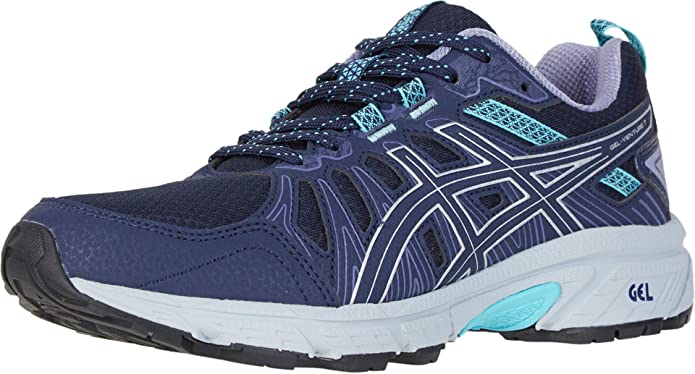
Editor’s Rating:
At a Glance:
- Shoe Type: Runner
- Size Availability: 5 to 12
- Upper Material: Synthetic Leather
- Sole Material: Gel / EVA Foam
Something very special about these shoes is their specificity with wide sizes. While it’s rare to find a shoe with wide sizes in the first place, and even rarer still to find wide shoes in half-sizes, this shoe has wide variations in every single size, half sizes included. For those looking for a wide shoe in a half size, or for those that want the flexibility to try out a few sizes, it’s one of the best options out there.
And while these shoes will be fine for the road miles many cross country coaches are fond of, they’re technically a part of Asics’ trail running lineup, making them even better suited for cross country running. With a gel-equipped midsole and a grippy traction pattern, this shoe can hold its own against spikes on the racecourse.
Asics, as is often the case, make shoes only a cross country runner could love in terms of looks. These are no different. Their trademark pattern is interlaced with several color schemes that simply don’t work very well. While usually, a simple black shoe can avoid most fashion faux pas issues, with this shoe we’d take the opposite approach: the best-looking variations have the brightest and most outlandish colors in our opinion.
Support
With a gel pouch designed to cushion and absorb repeated impacts and an EVA foam that molds to the sole of the foot, these wide-feet-oriented shoes are quite supportive and can help correct stride inefficiencies in both supinators and overpronators. The only thing to be aware of is it’s lightweight Ortholite sockliner upper, which might not provide enough ankle and foot support on more technical courses.
- Wide shoe available in a tremendous variety of sizes
- Help correct stride of both supinators and overpronators
- Grippy traction pattern
- Gel midsole absorbs impacts
- Sockliner may not provide adequate ankle support
- We don’t love the available color patterns
10. Under Armour Men’s Charged Assert 8 Running Shoe
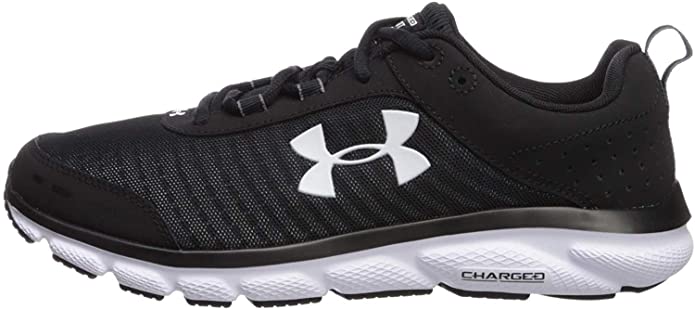
Editor’s Rating:
At a Glance:
- Shoe Type: Runner
- Size Availability: 7 to 15 in half-sizes (X-Wide sizes available)
- Upper Material: Synthetic Mesh
- Sole Material: Synthetic Rubber
It’s not necessarily fashionable, supportive, or lightweight, but the Under Armour Charged Assert 8 is a phenomenally well-rounded workhorse runner for anyone looking for a supportive, mid-range shoe. It’s also available in half-sizes and in Under Armour’s X-Wide format for wider feet.
Made with a fully synthetic construction (probably to reduce costs), the upper mesh isn’t particularly breathable or comfortable, but it’s sturdy enough to provide some foot support. The synthetic rubber sole is relatively supportive and has a built-in heel cup, although doesn’t necessarily offer supination or overpronation support (we’d recommend the Gel Venture 7s or Brooks Ghost 12, respectively). Under Armour’s idea of support comes more in the form of ankle and foot stabilization.
Color options are diverse but relatively unassuming, and these aren’t the best-looking or flashiest running shoes in our lineup, which is fine for most cross country runners’ purposes (we’re on a race course not a fashion runway after all.) The dyes are digitally printed, however, which means colors won’t run, stain, or fade with wear or sweat.
Support
The Under Armour shoes aren’t particularly supportive, but they do offer nice ankle and foot support for those who have difficulties with ankle weaknesses or imbalances. We’d prefer an EVA sole to a rubber synthetic one, but the Under Armour gets some impressive cushioning ability out the synthetic material. While these shoes might work for those who supinate or overpronate slightly, they’re really best suited for runners with a neutral stride.
- Cushioned trainer for those with a neutral stride
- Impressive cushioning ability for synthetic rubber sole
- Colors won’t run or stain with sweat
- Well rounded, workhorse runner
- Some with stride inconsistencies might want a more supportive shoe
- Rubber sole isn’t as comfortable as EVA foam
Guide to Buying the Best Cross Country Shoes for 2024
Buying a pair of cross country shoes is a process that’s a little more involved than picking up a soccer ball from your local big box store—it will require research, patience, and potentially testing out several shoes before you find the right fit for your body. Read on for some tips on exactly how to find the perfect shoes for running cross country
Running Gait
Incredibly important to think about when purchasing a running shoe is how the shoe will interface with your feet and your body. While a lucky few runners have near-perfect strides that require minimal support from a running shoe, most runners need a contoured sole that can help correct an imperfect gait and reduce the risk of discomfort and injury while running.
Pronation, Overpronation, and Supination
Each runner has a different and unique stride, and, as humans, how we run can often be asymmetrical or off-balance. The main philosophy with running shoes is that by adding support into the sole of the shoe, we can correct for these inconsistencies in our movement.
Supination can cause increased likelihood of repetitive use injuries, while overpronation can cause Achilles tendon and other issues. Adding support, either way, helps lead the way to reduced injury and increased comfort in athletes. Runners who have a less-than-perfect stride (about 99% of us) typically fall into one of three categories:
Pronators
Pronation, a technical term for a neutral gait, is what you want as a runner. If you pronate, your likelihood of repeated-use injury (like IT-band issues and stress fractures) decreases. One thing to note for pronators is that a shoe with support can actually worsen stride and increase the possibility of injury. Look for shoes labeled with ‘neutral support,’ such as our current favorite shoe.
Overpronators
Overpronators’ feet roll inwards as they run. It’s compensated in running shoes by a stiff and well-supported arch. Those who overpronate commonly experience shin splints and heel or arch pain. Our best premium shoe can help overpronators find their stride.
Supinators
Supination, the opposite of overpronation (also sometimes known as underpronation) is when the outside of the foot leans too far over when standing or running. It’s solved by adding material on the outside edge of the shoe.
How Can I Determine My Gait?
Knowing what shoe is the most supportive and how it corrects the stride isn’t much use if you don’t know your own stride. So how do you figure out what kind of gait you run with? There are three main methods in determining what type of running shoes you should get.
Phone a Friend
Determining your running gait by watching yourself is difficult to impossible, as any motion you might make to look at your feet can affect your stride. This means that the easiest and quickest way to figure out your running style is for someone else to take a look, preferably someone knowledgeable on the subject. A coach or experienced teammate is usually the ticket. While running on a treadmill is ideal, the hallmarks of supination and overpronation will be present even when just walking on flat ground.
Examine Your Running Shoes
A pair of well-worn running shoes can tell you a great deal about your running stride tendencies. Look for the most and least worn parts of the sole of your shoe. A well-worn inner edge indicates supination. Keep in mind that if you wear a shoe with support, some of that wear will be mitigated by the support. If your shoe is worn evenly, that means you’ve got the right pair, whether it’s a neutral shoe or a supportive one.
If your shoe is mostly worn out by the ball of your foot and your big toe, you probably overpronate. You can also set your shoes on a flat surface, and if they angle inward, that can be another sign you overpronate.
If you overpronate, we’d recommend a shoe like the Asics Men’s Gel-Venture 7. Supinators should look for a shoe more like the Mizuno Men’s Wave Inspire 16.
Examine Your Footprints
This strategy is a bit less precise and can be a little more difficult, but if you can find some level sand to walk through barefoot, you can get an idea of your stride tendencies. If the outside edge of your footprint is deeper than the inside, it could indicate supination (underpronation). If the general angle of your foot is angled towards the arch, it indicates overpronation.
Film Your Stride
The most involved but most accurate and insightful way to measure your stride comes via a camera and a treadmill. Set up a couple of angles, one from the back (the most important), one from the front, and a few from the sides. Play back the footage to conduct a detailed stride analysis. The best part about this is the fact that you can look at the footage in slow motion, picking up details even the most experienced eye couldn’t.
Minimalist, Barefoot, and Zero-Drop Running Shoes
In the last ten years, runners have increasingly embraced the idea of minimal or barefoot running shoes, lightweight shoes that offer a very small level of arch and heel support. Stripping away support theoretically facilitates the natural stride of the foot. Touted as a natural and healthy way to run, the category has taken off and now most major brands offer at least one barefoot/minimal model. We have a full article about these types of shoes, with our favorite picks, if this is something you’re interested in.
Minimalist Running Shoes
Minimalist running shoes interfere minimally with the running stride and typically offer lightweight construction, but some still include a small level of arch or heel support. Most cross country runners will prefer something with a little more support, although an ultra-lightweight cross country spike like the Asics Men’s Hyper XC could be considered a minimalist shoe.
Barefoot Running Shoes
Barefoot running shoes are only meant to protect the foot from road debris and other road hazards, and are therefore designed to interfere minimally with the natural running gait. For those with a neutral gait, they can be quite effective, but for those that need support, they can cause undue injury.
Zero-Drop Running Shoes
Zero-drop running shoes are a new, ultra-popular category of running shoes that represent a midpoint between support and barefoot running. These shoes have a flat bottom where the heel is equally elevated from the ground as the ball of the foot, leading to a neutral running posture.
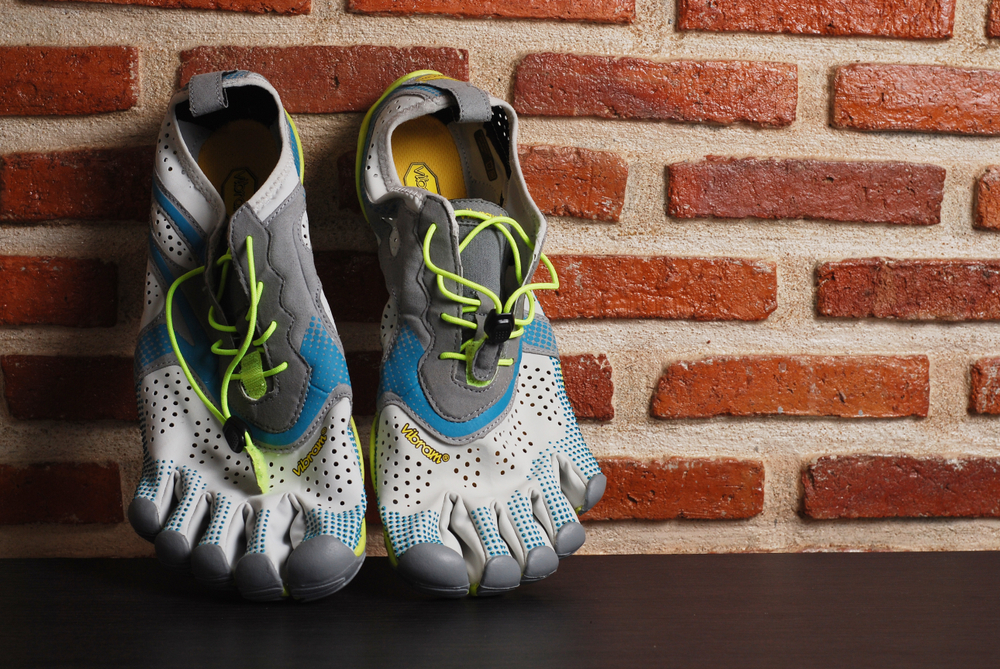
While minimalist, barefoot, and zero-drop running shoes have become popular over the last several years, most runners will be better served by conventional shoes. If you’re an experienced runner, consider picking up a pair of non-supportive shoes to experiment with, but understand that there is a small risk of repetitive-use injury (such as a stress fracture or plantar fasciitis) when trying out barefoot running without the proper preparation.
How Often Should I Replace My Shoes?
A hugely contentious topic in the running community is how often to replace a pair of shoes. Some runners advocate that running shoes can go until you’ve practically got bare feet touching the ground, while manufacturers and running stores (as expected) will have you thinking that you should pick up a new fair every few weeks. The real answer is somewhere in the middle: every 300 to 500 miles.
This can vary based on weight, running style, and surface. Pay attention to the following factors:
- Running Style: Those with an asymmetrical gait should replace shoes more often so as to not exacerbate any imbalances in a running stride. Periodically examine the sole of your running shoe. If you see any noticeable asymmetrical wear during these checkups, it’s time to pick up a new pair.
- Weight: While lightweight runners can get over 500 miles out of a pair of shoes, heavier runners over 200 pounds will look to replace their shoes about every 300 miles.
- Running Surface: Since cross country is an off-road sport, running shoes will last longer with a cross country runner than with a track runner. The harder the surface, the more frequently you’ll need to replace your shoe. Again, periodically examine the wear level on your shoe’s sole to evaluate if it should be replaced.
Do I Need Spikes for Cross Country Running?
At the college level of the sport, nearly every racer will wear lightweight spikes like the Asics Men’s Hyper XC during races to maximize performance. While a lightweight spike is a surefire way to shave a couple of seconds off of your personal record, middle and high school junior varsity runners will be fine without spikes. Keep in mind that spikes are only meant for racing conditions and shouldn’t be used for training runs.
The pressure and expectations climb as runners improve, and the faster a runner becomes, the more pressure they’ll have to upgrade to spikes. By senior year of high school, about 95% of runners will be using spikes. Our recommendation is that an athlete should purchase a pair of spikes once committed to running over 10 races (about one full season)
What Should I Wear for Cross Country Running?
Cross country running is not very equipment intensive, and you just need some lightweight running clothes and a pair of shoes to participate. Running effectively is all about wearing what keeps you comfortable, but if you’re looking for a cross country shopping list, we’ve broken down your apparel needs into two categories: clothes and accessories.
Running Clothes
A complete running ensemble can do more than complete a look, it can make the whole running experience more comfortable and enjoyable.
- Women’s Clothing
- Tops: The most popular tops in women’s cross country are form-fitting tank tops, but some women prefer to run and race in a sports bra. T-shirts and long-sleeve wicking shirts are also popular.
- Bottoms: Most cross-country women’s’ bottoms are typically mid-thigh versions with a comfortable liner. They’re made of wicking polyester that helps pull moisture away from the skin.
- Men’s Clothing:
- Tops: Men’s running tops can range from an ultra-lightweight style running ‘singlet’ to a heavier weight, long sleeve shirt. Most popular and versatile to run in are simple tee shirts made of synthetic wicking fabrics, typically nylon and polyester.
- Bottoms: Men’s bottoms are a contentious topic among fashion-conscious runners, with some advocating for ultra-short shorts that provide maximum range of motion and others preferring a slightly more modest, knee-length short. Our opinion? Wear whatever is most comfortable for you, but at the very least check out this list of our favorites.
Accessories
Other commonly-used accessories for a cross country wardrobe are heart rate monitors, which can help track your fitness progress, and running watches, which can use GPS technology to trace and build running routes. Also popular are wicking socks, running watches, headbands, and lightweight breathable running tights, sweatpants, and jackets for jogging and racing in cold weather.
Wrapping Up
Cross country is a lifelong sport that is rewarding socially, physically, and mentally. Since the only thing needed is a pair of running shoes, you can do it all over the world inexpensively. It’s true that everywhere you go, there’s a dedicated running scene with some beautiful running routes and a high school cross country team.
Since the only investment required to start running cross country is a nice pair of shoes, it’s a great idea to invest in a quality pair of shoes to make your transition into the sport comfortable and pleasant. We’ll see you out on the course!
